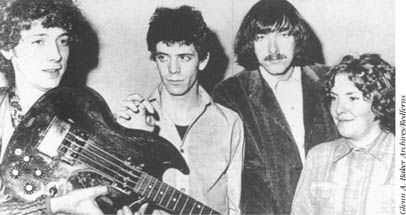
The Velvet Underground (Sterling Morrison (left), Lou Reed, John Cale, and Mo Tucker) are now viewed as one of the most influential and innovative bands of the 1960s.
For a band that never had a hit single between 1965 and 1970, the Velvet Underground (VU) had an almost mythic influence on subsequent rock artists, from 1970s singers such as David BOWIE and Patti Smith, to 1990s grunge rockers like Sonic Youth. The main creative architects of the VU’s dark, confrontational sound were Lou Reed and John Cale, who met at Syracuse University in upstate New York.
After graduating, Reed (b. March 2, 1942) became a staff songwriter at Long Island’s Pickwick Records. Cale (b. December 4, 1940) had studied classical music in Britain before winning a scholarship to the U.S. Teaming up with guitarist Sterling Morrison (1942-95), Reed and Cale played local clubs as the Warlocks and the Falling Spikes. After replacing their drummer with Maureen (Mo) Tucker (b. 1945), they renamed themselves The Velvet Underground and became pop artist Andy Warhol’s house band. Warhol added Nico (b. October 16, 1938), a German singer with a Dietrich-like voice, to the mix and booked the VU for his 1966 psychedelic show, the Exploding Plastic Inevitable. The group’s 1967 debut album, The Velvet Underground and Nico, with its famous peelable-banana cover, was produced by Warhol. Riddled with discordant rhythms and screeching feedback, this now-landmark album of dark city life—made up of powerful songs about drugs and sex—was a resounding commercial flop.

The Velvet Underground (Sterling Morrison (left), Lou Reed, John Cale, and Mo Tucker) are now viewed as one of the most influential and innovative bands of the 1960s.
After Warhol lost interest, (taking his financial support with him), and Nico was fired, the Velvets released an equally unsuccessful second album, White Light/White Heat (1968). Internal dissension escalated until Reed fired Cale and replaced him with bassist Doug Yule. A third album, 1969’s The Velvet Underground, had a hauntingly gentle sound and an odd mix of songs about nihilism, Jesus, and adultery. Although dropped by their record label, the band recorded Loaded (Atlantic, 1970), a near-perfect rock album filled with classics like ”Sweet Jane” and ”Rock and Roll.” Ironically, Reed quit and the group split up just as the VU seemed poised for commercial success.
In the late 1970s and through the 1980s, the band gradually acquired legendary status. In 1993, the original Velvets regrouped for a highly successful tour and live album. But after Morrison died of cancer in Poughkeepsie, New York, on August 30, 1995, Reed decided that was the end of the Velvet Underground. Tucker, however, keeps the VU’s legacy alive with a series of off beat solo albums.
Michael R. Ross
SEE ALSO: GRUNGE; PUNK ROCK; ROCK MUSIC.
FURTHER READING
Bockris, Victor, and Gerald Malanga. Up-Tight: The Story of the Velvet Underground (London: Omnibus Press, 1996);
Reed, Lou. Between Thought and Expression (New York: Hyperion Books, 1991);
Zak, Albin, III. The Velvet Underground Companion (New York: Schirmer Books, 1997).
SUGGESTED LISTENING
Loaded; Peel Slowly and See (5-CD set); The Velvet Underground-, The Velvet Underground and Nico; White Light, White Heat; Lou Reed: Between Thought and Expression.